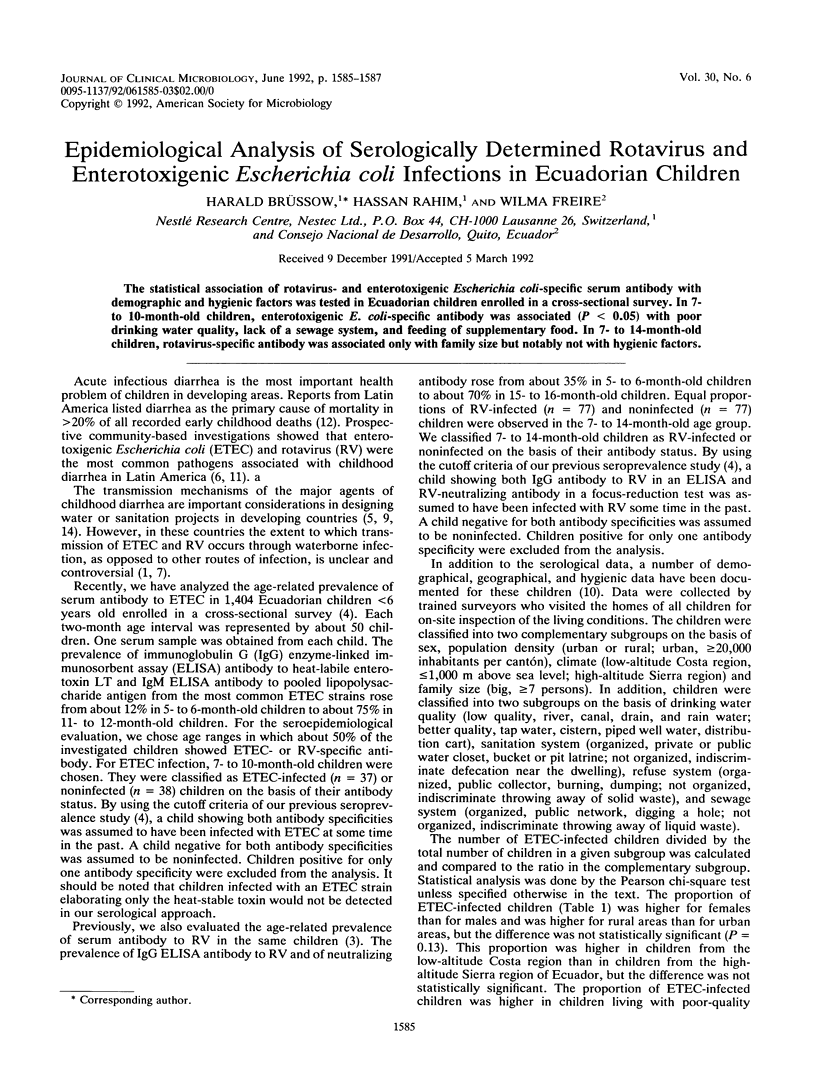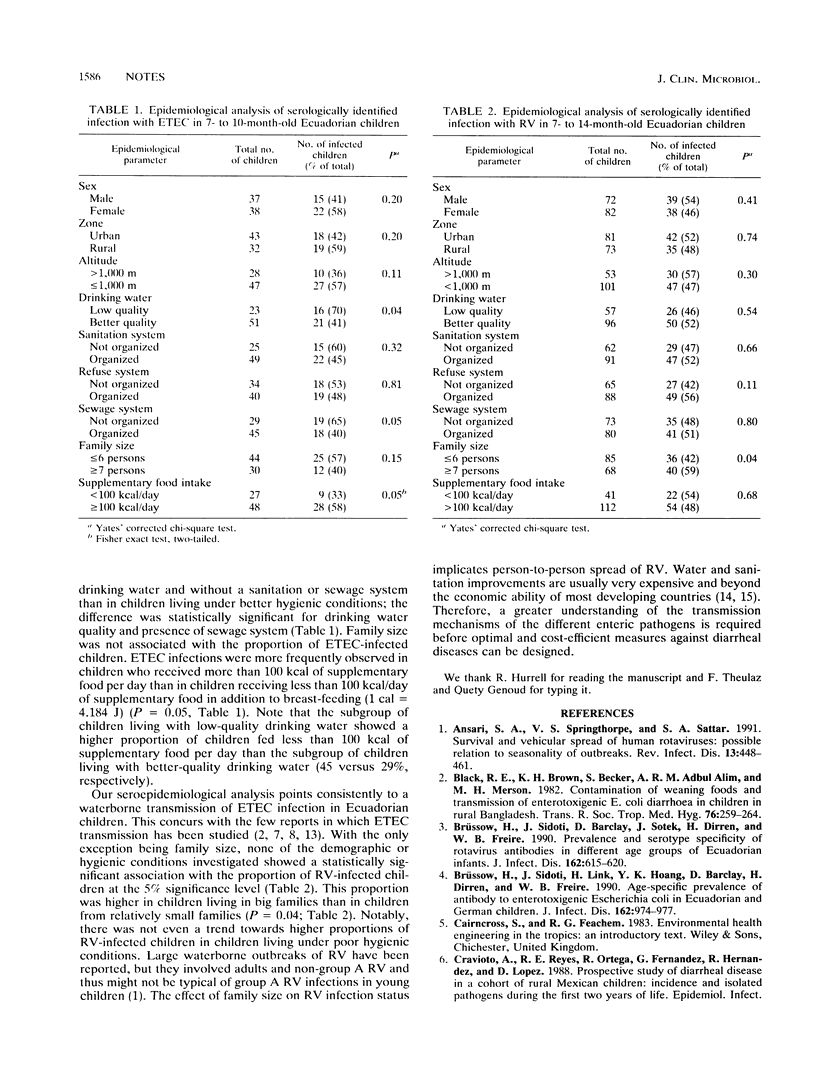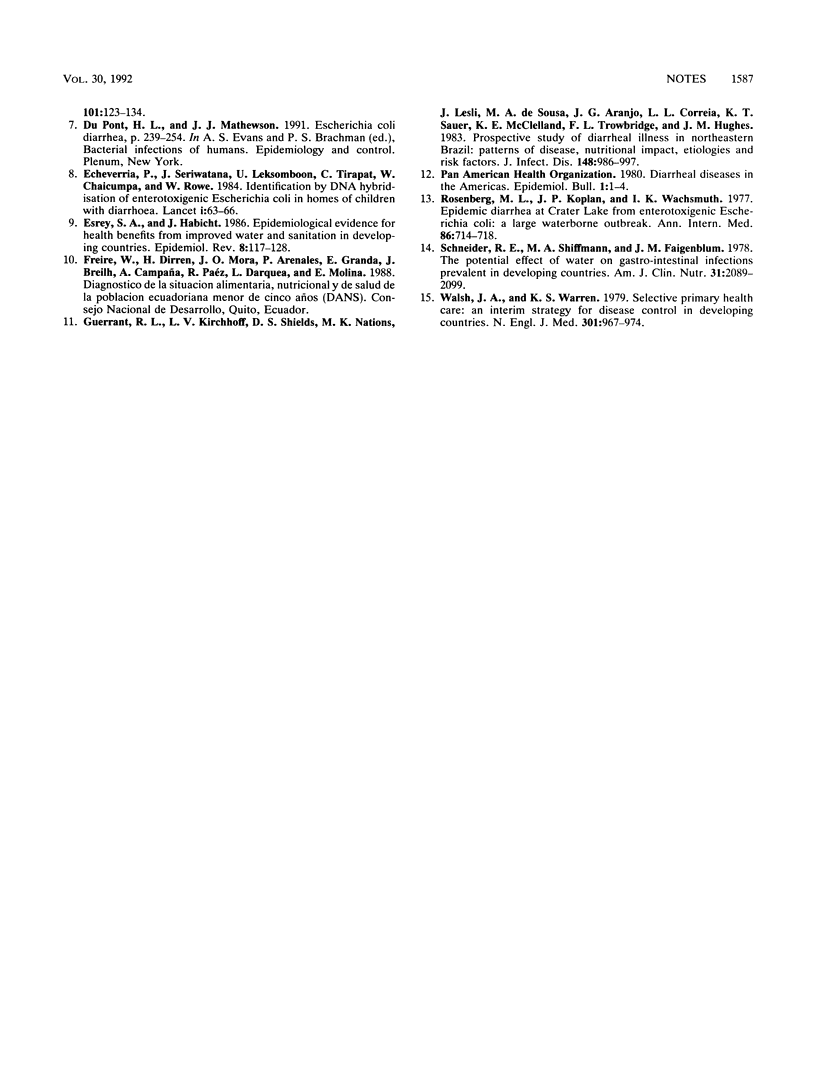Abstract
The statistical association of rotavirus- and enterotoxigenic Escherichia coli-specific serum antibody with demographic and hygienic factors was tested in Ecuadorian children enrolled in a cross-sectional survey. In 7- to 10-month-old children, enterotoxigenic E. coli-specific antibody was associated (P less than 0.05) with poor drinking water quality, lack of a sewage system, and feeding of supplementary food. In 7- to 14-month-old children, rotavirus-specific antibody was associated only with family size but notably not with hygienic factors.
Full text
PDF


Selected References
These references are in PubMed. This may not be the complete list of references from this article.
- Ansari S. A., Springthorpe V. S., Sattar S. A. Survival and vehicular spread of human rotaviruses: possible relation to seasonality of outbreaks. Rev Infect Dis. 1991 May-Jun;13(3):448–461. doi: 10.1093/clinids/13.3.448. [DOI] [PubMed] [Google Scholar]
- Black R. E., Brown K. H., Becker S., Alim A. R., Merson M. H. Contamination of weaning foods and transmission of enterotoxigenic Escherichia coli diarrhoea in children in rural Bangladesh. Trans R Soc Trop Med Hyg. 1982;76(2):259–264. doi: 10.1016/0035-9203(82)90292-9. [DOI] [PubMed] [Google Scholar]
- Brüssow H., Sidoti J., Barclay D., Sotek J., Dirren H., Freire W. B. Prevalence and serotype specificity of rotavirus antibodies in different age groups of Ecuadorian infants. J Infect Dis. 1990 Sep;162(3):615–620. doi: 10.1093/infdis/162.3.615. [DOI] [PubMed] [Google Scholar]
- Brüssow H., Sidoti J., Link H., Hoang Y. K., Barclay D., Dirren H., Freire W. B. Age-specific prevalence of antibody to enterotoxigenic Escherichia coli in Ecuadorian and German children. J Infect Dis. 1990 Oct;162(4):974–977. doi: 10.1093/infdis/162.4.974. [DOI] [PubMed] [Google Scholar]
- Echeverria P., Seriwatana J., Leksomboon U., Tirapat C., Chaicumpa W., Rowe B. Identification by DNA hybridisation of enterotoxigenic Escherichia coli in homes of children with diarrhoea. Lancet. 1984 Jan 14;1(8368):63–66. doi: 10.1016/s0140-6736(84)90001-1. [DOI] [PubMed] [Google Scholar]
- Esrey S. A., Habicht J. P. Epidemiologic evidence for health benefits from improved water and sanitation in developing countries. Epidemiol Rev. 1986;8:117–128. doi: 10.1093/oxfordjournals.epirev.a036290. [DOI] [PubMed] [Google Scholar]
- Guerrant R. L., Kirchhoff L. V., Shields D. S., Nations M. K., Leslie J., de Sousa M. A., Araujo J. G., Correia L. L., Sauer K. T., McClelland K. E. Prospective study of diarrheal illnesses in northeastern Brazil: patterns of disease, nutritional impact, etiologies, and risk factors. J Infect Dis. 1983 Dec;148(6):986–997. doi: 10.1093/infdis/148.6.986. [DOI] [PubMed] [Google Scholar]
- Rosenberg M. L., Koplan J. P., Wachsmuth I. K., Wells J. G., Gangarosa E. J., Guerrant R. L., Sack D. A. Epidemic diarrhea at Crater Lake from enterotoxigenic Escherichia coli. A large waterborne outbreak. Ann Intern Med. 1977 Jun;86(6):714–718. doi: 10.7326/0003-4819-86-6-714. [DOI] [PubMed] [Google Scholar]
- Schneider R. E., Shiffman M., Faigenblum J. The potential effect of water on gastrointestinal infections prevalent in developing countries. Am J Clin Nutr. 1978 Nov;31(11):2089–2099. doi: 10.1093/ajcn/31.11.2089. [DOI] [PubMed] [Google Scholar]
- Walsh J. A., Warren K. S. Selective primary health care: an interim strategy for disease control in developing countries. N Engl J Med. 1979 Nov 1;301(18):967–974. doi: 10.1056/NEJM197911013011804. [DOI] [PubMed] [Google Scholar]


